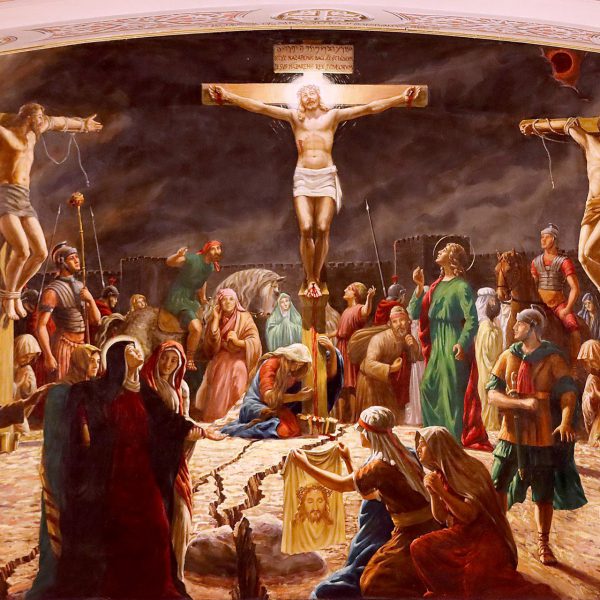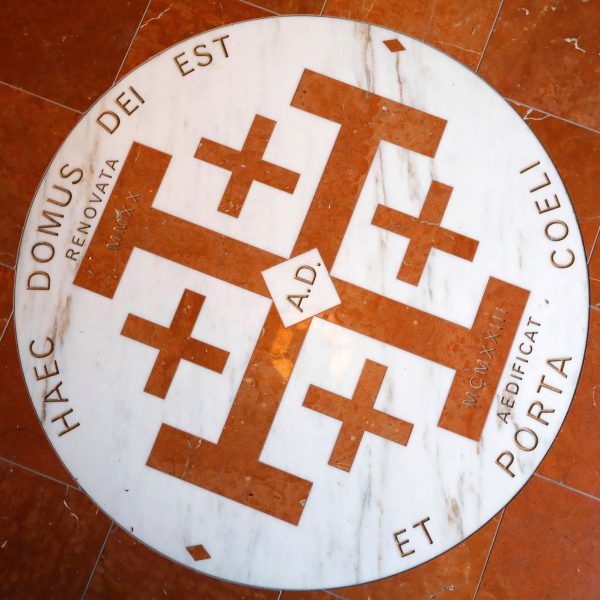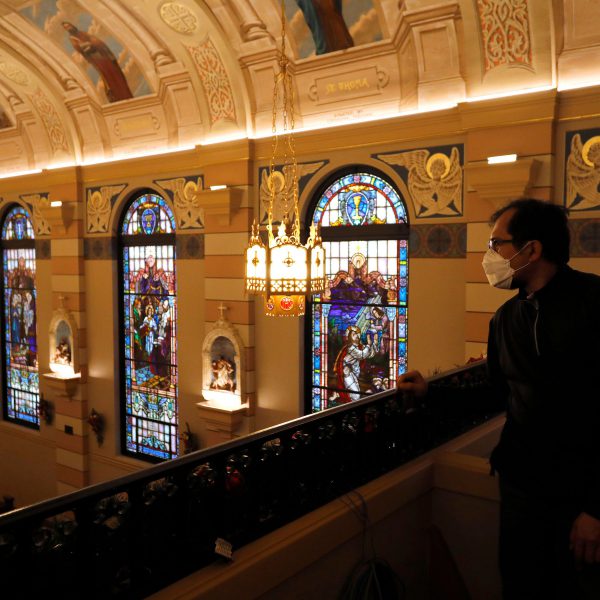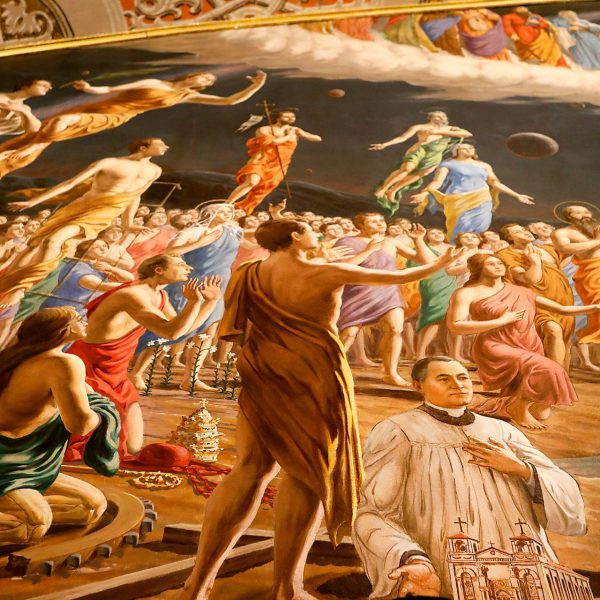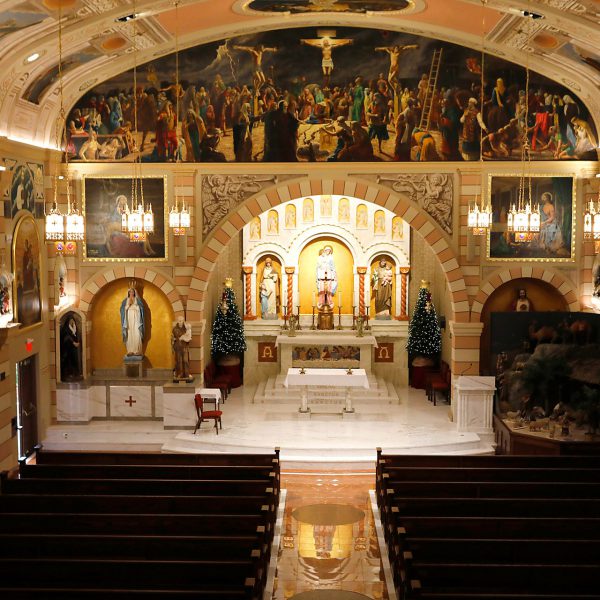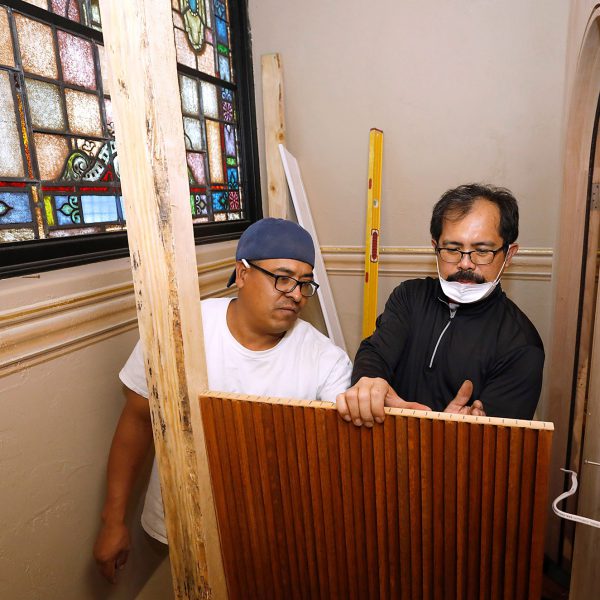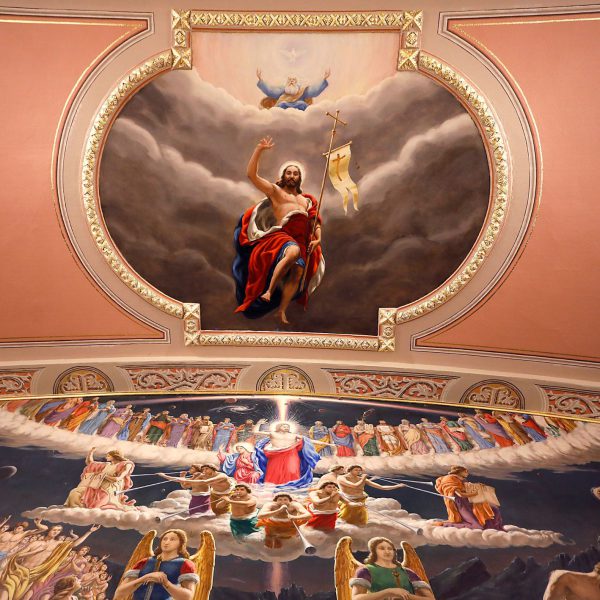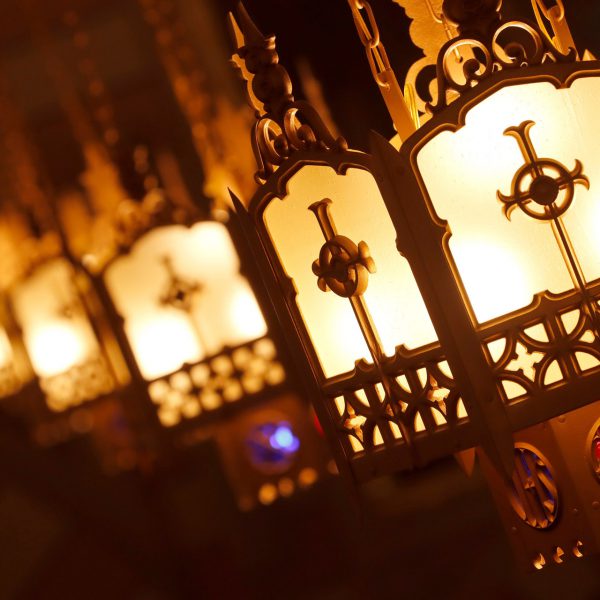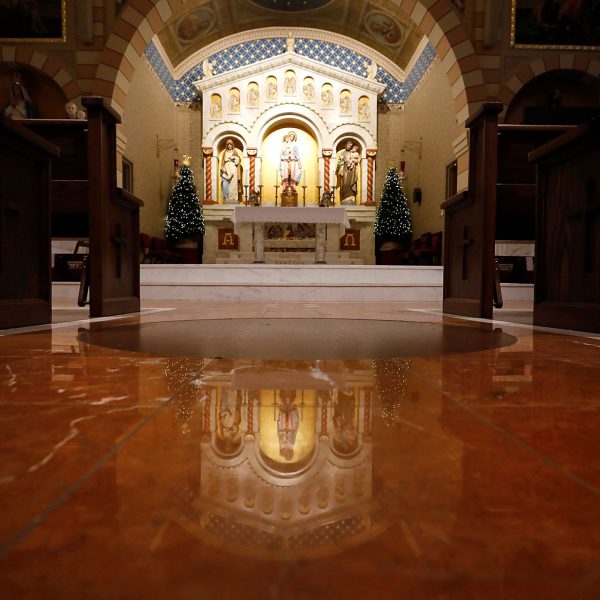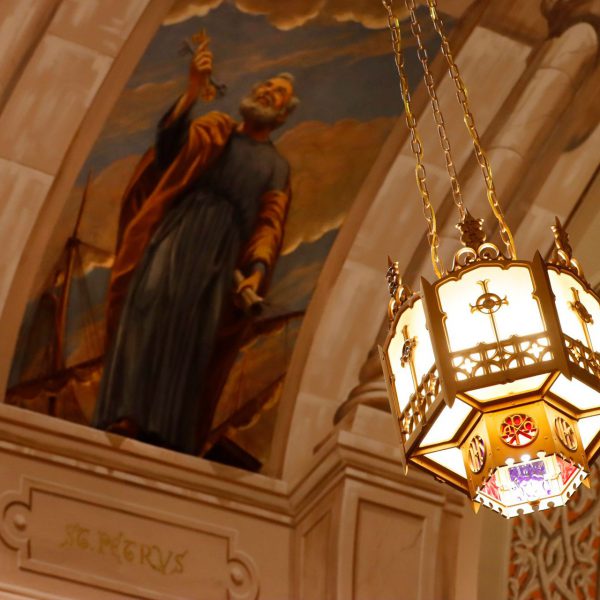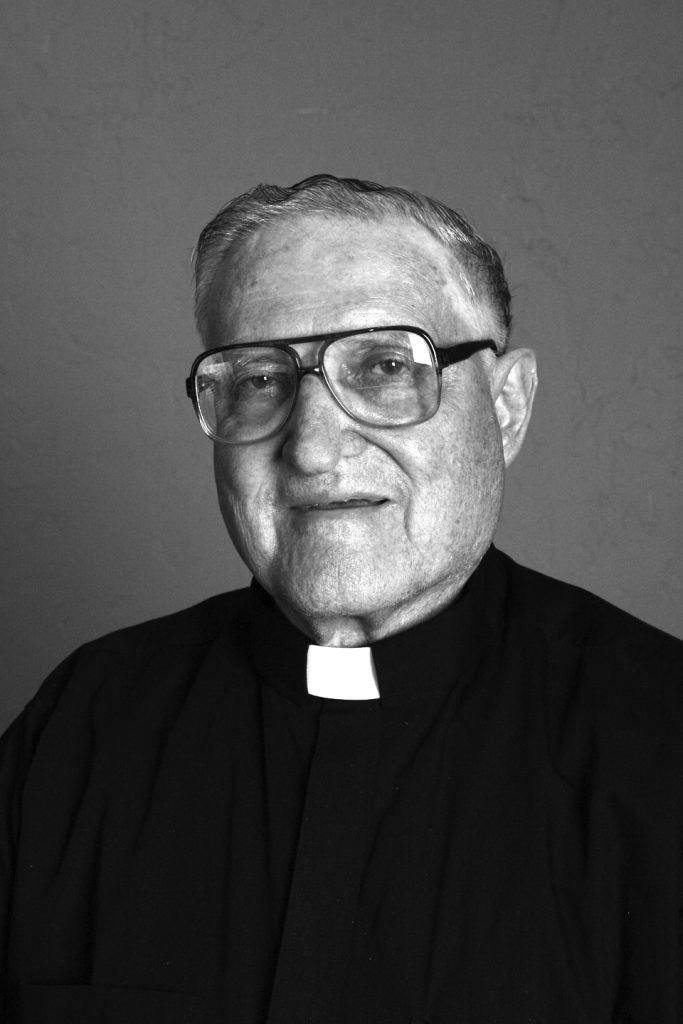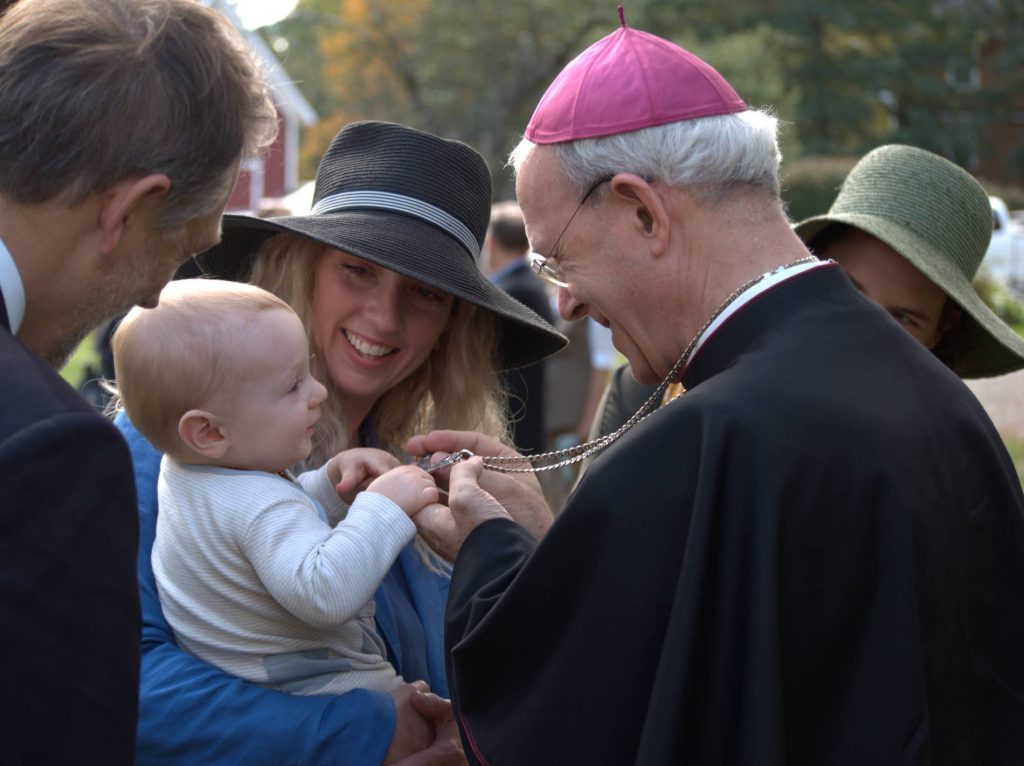SAN DIEGO – After a $2.4-million restoration, the small Catholic church nicknamed “The Jewel of Little Italy” is now more stunning than ever.
Our Lady of the Rosary Church, which will celebrate its centennial in 2025, has long been recognized for its artistic beauty. Ornate murals depicting biblical scenes like the Crucifixion and the Last Judgment, as well as paintings of figures like the Twelve Apostles, adorn the walls and the ceiling.
A 2017 article in the National Catholic Register included Our Lady of the Rosary as fourth among “5 of the Most Beautiful Churches in California.”
Still, 95 years have taken their toll on the church, built to serve the Italian immigrant community and modeled after the churches of their homeland.
Barnabite Father Joseph Tabigue, the parish’s pastor since 2011, said cracks had formed in the church’s ceiling, its vibrant frescoes by Venetian painter Fausto Tasca had darkened with decades of dust and grime, and the red carpeting installed in the 1960s had never been replaced.
The restoration work began Jan. 7, 2020, and concluded in early October, said Father Tabigue. When one sees the final result, “your jaw just drops.”
In early October, the pastor allowed parishioners to get a glimpse of the interior of the church after they attended Mass outdoors. The parish was able to celebrate its Masses inside the church starting on Oct. 25. Just three Sundays later, however, the pastor had to close the parish doors once more due to the spike in cases.
Patricia J. Kaszas, a 72-year-old parishioner who served as the project liaison, said the parish knew as early as 2013 that restoration efforts would be necessary in the 300-capacity church.
She explained that, if nothing had been done, Tasca’s paintings likely would have been “lost forever; it was just a matter of time.”
Maria Sardina, who was baptized at Our Lady of the Rosary Parish in 1948 and has been a parishioner ever since, said that the church’s appearance, “although always beautiful, became very tired.”
“Over the years,” she said, “a Band-Aid approach was taken for repairs – a little paint here and there – but not a total makeover.”
The goal of the restoration was to return the church to its original glory while also making a few upgrades, including electrical rewiring and the installation of two air-conditioning units, an improved sound system and some marble flooring, including an entryway marble inlay of the Jerusalem Cross. Also, a new confessional room with custom stained-glass art from Rembrandt’s “The Return of the Prodigal Son” was designed.
Among other things, old varnish was removed from the paintings, which were meticulously retouched. The canvases for some of them had been peeling off the ceiling and needed to be reattached.
The pews were removed and re-stained to their original darker color; the old wooden flooring beneath them was also taken up, refinished and reinstalled. Terracotta-colored stripes that had once adorned the arches and columns throughout the church, but had been painted over in the intervening decades, were reintroduced.
Luke Vinci, 41, served as fundraising chair for the restoration. He said the difference between the church before and after is like “night and day.”
“The most striking change from the restoration was a treasure underneath 90-plus years of dirt,” he said, referring to the restored artworks. “What appeared to be gray in many cases on the art is now white or sometimes a vibrant blue.”
Sardina said that some of the smaller details in the paintings, including depictions of angels and saints, were rediscovered.
“The paintings and the stories they tell can now be fully enjoyed,” she said.
Not all of the changes made during the restoration were mere re-creations of the original design. However, even the few completely new features were compatible with it.
Father Tabigue explained that the gold leaf paint recently added to various artworks and used as a backdrop for the church’s statues had been inspired by research into Italian churches.
Of the decision to replace the church’s red carpeting with reddish “Rojo Alicante” marble flooring in the sanctuary and the aisles, Father Tabigue noted that marble is commonly used in Italian churches and is something that might have been employed at Our Lady of the Rosary at the beginning if it hadn’t been cost-prohibitive.
To complement the church’s stained-glass windows, which depict the Joyful, Sorrowful and Glorious Mysteries of the rosary, the Luminous Mysteries will be added in mosaic form in the church’s central aisle flooring next spring. The Luminous Mysteries, which include the Baptism of Jesus, the Wedding of Cana, the Proclamation of the Kingdom, the Transfiguration, and the Institution of the Eucharist, were introduced in 2002 by Pope St. John Paul II.
Only mosaics of the first four Luminous Mysteries will have to be installed, because the fifth and final Luminous Mystery was already present in the church: A relief panel of the Last Supper adorns the church’s high altar.
Planning for the restoration started in 2012. Fundraising officially began on Oct. 7, 2018, the feast of Our Lady of the Rosary. The parish surpassed its capital campaign goal of $2.5 million, meaning that it has not incurred any debt for the restoration. There were more than 800 generous donors.
Father Tabigue said that many answered the call, and he is grateful.
The pastor explained that, just as the parish church originally served as a welcoming home for Italian immigrants, he hoped the newly restored church might be a home for contemporary Catholics, where they can find “peace, and consolation, and the spiritual things that we all are searching for.”
Sardina echoed those sentiments.
“I do believe that, as the word of our beautifully restored church gets out, more and more people will come to visit,” she said, “and, under our roof, the Word of God will be present.”
Our Lady of the Rosary is located at 1668 State St., San Diego, 92101, web olrsd.org.
ITALIAN BEAUTY: The founders of Our Lady of the Rosary wanted the church’s interior to reflect the artistic traditions in Italy. Renowned painter Fausto Tasca, from Venice, was hired to paint murals to cover the sanctuary walls and ceiling, including “The Crucifixion” above the altar, and to design the stained glass windows.
VIBRANT: The artwork, nearly 100 years old, was painstainkingly cleaned and restored to its original glory. Father Joseph Tabigue has led the parish since 2011.

